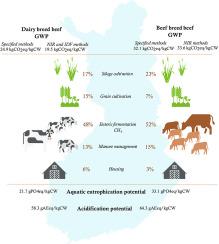Agricultural Systems ( IF 6.1 ) Pub Date : 2021-08-21 , DOI: 10.1016/j.agsy.2021.103250 Sanna Hietala , Hannele Heusala , Juha-Matti Katajajuuri , Kirsi Järvenranta , Perttu Virkajärvi , Arto Huuskonen , Jouni Nousiainen

|
CONTEXT and OBJECTIVE
Objective of this study was to define current typical Finnish beef production systems and to estimate the environmental impacts of Finnish beef.
METHODS
Environmental impacts were estimated using life cycle assessment (LCA) approach with key impact categories; global warming (GWP), eutrophication and acidification potential. Both beef and dairy breed -based systems were investigated separately and, in more detail, separately for heifers, bulls and cows. In addition, regarding GWP, assessment with more specified greenhouse gas emission models were compared to assessment with models used in Finnish National Inventory Report (NIR).To gain detailed knowledge of the environmental impacts and mitigation potential in Finnish beef production system, environmental LCA model was integrated to biological plant and animal production models. Dynamic assessment model was constructed to provide a direct presentation of the effects of shifting diet, slaughter age or weight to GWP, eutrophication, acidification from all sources simultaneously.
RESULTS AND CONCLUSIONS
The GWP of Finnish beef fattening phase varied from 16.2 to 20.0 kgCO2-eq./kg carcass weight (CW) with specified methods and from 16.8 to 19.2 kgCO2-eq./kgCW with NIR methods. The average dairy breed beef GWP resulted 24.9 kgCO2-eq./kgCW, while the beef breed beef GWP was 32.1 kgCO2-eq./kgCW with specified emission models. With IDF allocation and NIR methods, GWP of average dairy breed beef was 19.5 kgCO2-eq./kgCW and for average beef breed beef it was 33.6 kgCO2-eq./kgCW. The aquatic eutrophication the average dairy breed beef resulted 21.7 gPO4-eq./kg CW, while for the average beef breed beef it was 33.1 gPO4-eq./kgCW. Acidification potential of average dairy beef was 58.3 gAE-eq/kgCW and of average beef breed beef was 64.3 gAE-eq./kg CW. When the IDF allocation was used with specified assessment methods, the GWP of beef from dairy breed cattle was estimated nearly 20% lower compared to allocation based on Finnish feeding requirements.
SIGNIFICANCE
Present study showed that in the current Finnish beef production the dairy breed beef had significantly lower environmental load in all three impact categories. It was observed that the specified methods, which were able to distinguish differences between annual and perennial crops and take the feed quality better into account, gave significantly different results when compared to NIR methods. As the LCA model was constructed to provide assessment tool for further scenario comparisons, the specified methods were considered to give better resolution for these assessments.
中文翻译:

芬兰牛肉的环境生命周期评估——乳制品和牛肉品种牛肉生产的从摇篮到农场的大门分析
背景和目标
本研究的目的是确定当前典型的芬兰牛肉生产系统,并评估芬兰牛肉对环境的影响。
方法
使用生命周期评估 (LCA) 方法和关键影响类别估算环境影响;全球变暖 (GWP)、富营养化和酸化潜力。分别对基于牛肉和奶牛品种的系统进行了调查,更详细地,分别针对小母牛、公牛和奶牛进行了调查。此外,关于 GWP,将使用更具体的温室气体排放模型的评估与芬兰国家清单报告 (NIR) 中使用的模型进行比较。为了详细了解芬兰牛肉生产系统的环境影响和减缓潜力,环境 LCA 模型被整合到生物植物和动物生产模型中。构建动态评估模型,以直接展示改变饮食、屠宰年龄或体重对 GWP、富营养化、
结果和结论
芬兰牛肉育肥阶段的 GWP 在指定方法下为 16.2 至 20.0 kgCO2-eq./kg 胴体重 (CW),使用 NIR 方法为 16.8 至 19.2 kgCO2-eq./kgCW。奶牛牛肉的平均 GWP 为 24.9 kgCO2-eq./kgCW,而牛肉品种牛肉的 GWP 为 32.1 kgCO2-eq./kgCW,具有指定的排放模型。使用 IDF 分配和 NIR 方法,平均奶牛的 GWP 为 19.5 kgCO2-eq./kgCW,而普通牛肉品种的 GWP 为 33.6 kgCO2-eq./kgCW。水生富营养化,平均奶牛品种为 21.7 gPO4-eq./kg CW,而平均牛肉品种为 33.1 gPO4-eq./kgCW。平均乳牛肉的酸化潜力为 58.3 gAE-eq/kgCW,普通牛肉品种的酸化潜力为 64.3 gAE-eq./kg CW。当 IDF 分配与指定的评估方法一起使用时,
意义
目前的研究表明,在目前的芬兰牛肉生产中,奶牛在所有三个影响类别中的环境负荷都显着降低。据观察,与 NIR 方法相比,能够区分一年生作物和多年生作物之间的差异并更好地考虑饲料质量的特定方法给出了显着不同的结果。由于构建 LCA 模型是为了为进一步的情景比较提供评估工具,因此考虑了指定的方法来为这些评估提供更好的解决方案。











































 京公网安备 11010802027423号
京公网安备 11010802027423号